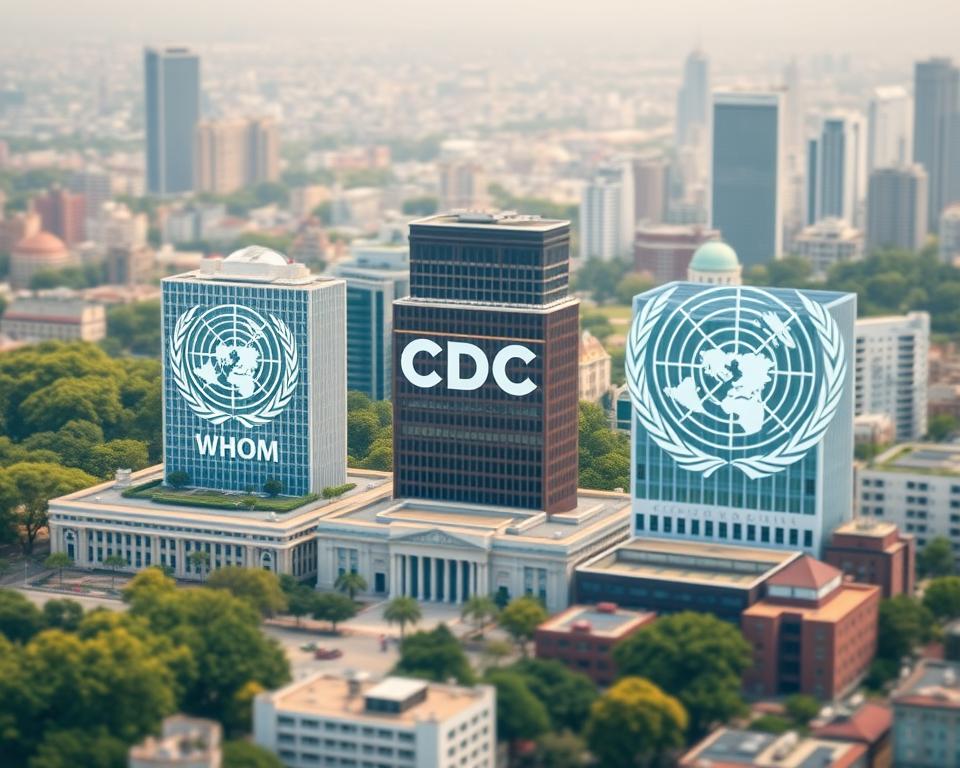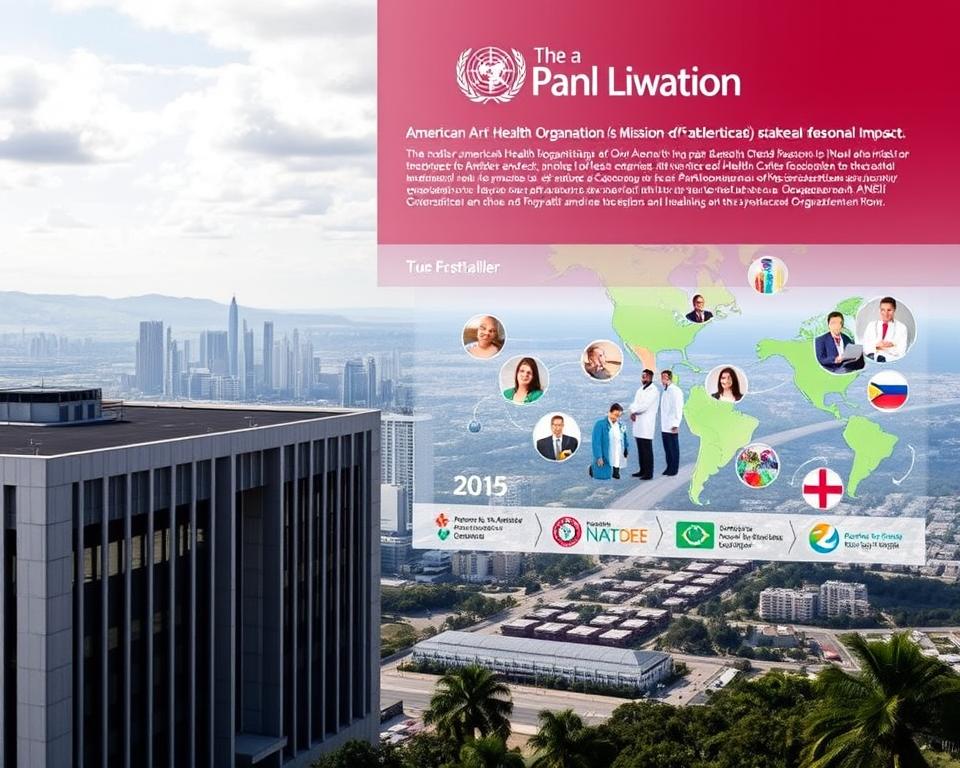
Discover the Founders of the Pan American Health Organization
Did you know that over 900 million people benefit from the healthcare initiatives spearheaded by the Pan American Health Organization? Established in 1902, PAHO stands as the first international public health organization, forging a path for unified health improvements across the Americas. The pan american health organization founders envisioned a cooperative framework that promotes health and wellness on a massive scale, laying down foundational principles that still resonate today.
The significant contributions and the unwavering commitment of the founders of PAHO have left an indelible mark on the region’s public health landscape. With an acute awareness of the challenges faced by diverse populations, these pioneering leaders sought to enhance the well-being of millions. Join us as we explore the rich pan american health organization history that highlights the vision and dedication of these remarkable individuals.

Key Takeaways
- The Pan American Health Organization was founded in 1902.
- PAHO has influenced the health of over 900 million people across the Americas.
- International cooperation was key to its mission from the very beginning.
- The founders of PAHO set the stage for modern public health initiatives.
- PAHO’s work is rooted in enhancing health and wellness throughout diverse communities.
Introduction to the Pan American Health Organization
The Pan American Health Organization (PAHO) serves as a vital entity in the realm of public health across the Americas. Established as a specialized agency of the World Health Organization (WHO), PAHO plays a critical role in coordinating efforts to address diverse health challenges throughout the region. Its origins date back to the late 19th century when the need for a collaborative approach to tackle infectious diseases became evident.
Since its establishment, PAHO has focused on enhancing health equity among its member nations, ensuring that all populations have access to quality healthcare services. This goal reflects the organization’s commitment to not just respond to health emergencies but also to improve overall public health systems within various communities. The pan american health organization origin is rooted in the shared vision of promoting health as a fundamental human right, which drives its initiatives and programs today.
By fostering partnerships and facilitating knowledge sharing, PAHO continues to lead initiatives aimed at improving health outcomes. Its work encompasses a wide range of areas such as disease prevention, maternal and child health, and the response to climate change’s impacts on health. Every program and strategy aligns with the overarching mission of the pan american health organization establishment to create a healthier future for all individuals in the Americas.
| Year | Significant Event |
|---|---|
| 1902 | Foundation of the International Sanitary Bureau |
| 1947 | Creation of the Pan American Health Organization |
| 1958 | PAHO becomes a specialized agency of WHO |
| 2003 | Launch of regional health initiatives |
History of Public Health in the Americas
The pan american health organization history is deeply rooted in the early public health struggles faced by the Americas. Throughout the 19th and early 20th centuries, nations grappled with numerous health challenges including epidemics of yellow fever, smallpox, and tuberculosis. These challenges necessitated a collaborative approach to health management, which led to the concept of regional cooperation.
Emerging from these pressing health issues, the pan american health organization founding members recognized the need for a unified strategy to tackle public health crises. This recognition came at a time when individual countries often struggled to address health concerns effectively on their own. Countries began to share knowledge, resources, and strategies, paving the way for improved health outcomes across the continent.
The latter part of the 20th century showcased significant advancements in public health policies within the Americas. Major shifts in health priorities reflected a growing awareness of interconnected health systems. By understanding the historical context of these developments, the role of the pan american health organization becomes clear. The organization’s creation represented a culmination of efforts to enhance regional health cooperation amidst global health trends.

The Vision Behind the Pan American Health Organization
The pan american health organization vision represents a foundational commitment to enhancing the health and well-being of the people across the Americas. This vision embodies the crucial ideals put forth by the founders of PAHO, focusing on health promotion, disease prevention, and the continuous improvement of healthcare services. Their resolute aim was to establish a framework that prioritizes collaboration among nations to tackle health challenges effectively.
This visionary approach supports not only the enhancement of public health systems but also fosters an environment where communities can thrive. The founders of paho recognized that addressing social determinants of health plays a vital role in achieving overall health equity. By adhering to a proactive, collaborative model, PAHO’s founders set forth ambitious goals that still resonate in the context of today’s complex public health landscape.
As current health challenges evolve, the alignment of PAHO’s founding goals with contemporary needs has never been more relevant. The organization’s vision encourages nations to work together, ensuring that public health policies are adaptable, inclusive, and effective in promoting the health of all individuals across diverse populations.
Key Figures Among the Founders of the Pan American Health Organization
The establishment of the Pan American Health Organization (PAHO) owes much to the vision and dedication of its founders. Key figures emerged during the formative years, exemplifying leadership and innovative thinking. These pioneering leaders shaped the organization’s mission and direction, laying the groundwork for public health initiatives across the Americas.
Overview of Pioneering Leaders
Among the notable paho founders, Dr. George W. Foster stands out for his unwavering commitment to the control and prevention of diseases. His leadership emphasized the importance of integrating health policies across the continent. Another significant figure, Dr. José Celso Barbosa, championed health education and played a vital role in improving public health infrastructure in Puerto Rico, which influenced broader regional efforts.
Contributions of Early Members
The contributions of early members were equally instrumental in advancing PAHO’s objectives. They focused on addressing communicable diseases such as yellow fever and tuberculosis, implementing innovative health programs that promoted awareness and education. These initiatives laid the foundation for future health campaigns, demonstrating the collaborative spirit among the paho founders.
Significant Milestones in the Establishment of PAHO
The journey of the Pan American Health Organization began with the International Sanitary Conferences in the late 19th century, which laid the groundwork for international cooperation on health issues. This pivotal event marked the beginning of the pan american health organization establishment, focusing on managing infectious diseases and improving public health standards among the nations of the Americas.
In 1949, the formal adoption of PAHO’s constitution took a significant step toward establishing a structured public health organization. This moment in the paho establishment solidified the commitment of member states to collaborate on health programs and policies. As a result, various health initiatives emerged, addressing pressing health challenges such as malaria and tuberculosis.
The introduction of health programs in the 1960s enhanced PAHO’s impact, exemplifying the organization’s ability to adapt and respond to the evolving needs of the Americas. Collaborative efforts with diverse nations fostered a sense of unity and collective responsibility, showcasing the effectiveness of the pan american health organization establishment.
Governance structure evolved through established regional offices, allowing for enhanced coordination and response to health emergencies. This evolution positioned PAHO as a central figure in public health, reflecting the growing importance of international collaboration in managing global health issues.
Pan American Health Organization Founders: Their Legacy on Global Health
The legacy of PAHO founders extends far beyond their original vision, permeating various levels of global health practices. Their pioneering spirit has shaped public health policies that significantly benefit nations today. Initiatives like vaccination campaigns, disease prevention strategies, and health education programs all trace their roots back to the foundational efforts of these remarkable individuals.
One of the key aspects of the legacy of PAHO founders is their commitment to collaboration. By fostering partnerships among nations, they promoted a holistic approach to health management. This collaborative environment has resulted in innovative strategies adopted globally, addressing pressing health challenges across different regions.
Specific policies introduced under the guidance of the pan american health organization founders have had long-lasting effects. For instance, the regional focus on communicable disease control has enhanced surveillance systems and improved response mechanisms. The spotlight on maternal and child health has led to advancements in healthcare systems, saving countless lives and improving health outcomes.
As PAHO continues to evolve, the influence of its founders remains evident in contemporary health initiatives. Their foresight created a blueprint that continues to guide public health actions aimed at enhancing health equity across the Americas and the world.
| Key Health Initiatives | Impact |
|---|---|
| Vaccination Campaigns | Increased immunization coverage, reducing outbreaks of infectious diseases |
| Chronic Disease Prevention | Implemented lifestyle interventions leading to better public health |
| Mental Health Awareness Programs | Enhanced understanding and support for mental health issues |
How PAHO Influenced Health Policies Across the Americas
The Pan American Health Organization (PAHO) has played a significant role in shaping health policies throughout the Americas. With its rich history, PAHO has provided essential frameworks that guide national health practices. Member countries have benefited from PAHO’s expert recommendations, which have helped develop a multitude of health initiatives.
One notable example of the PAHO influence on health policies is the focus on vaccination programs. Countries following PAHO’s guidelines have successfully reduced incidences of preventable diseases. This initiative reflects the organization’s commitment to improving health standards across the region. By aligning national health policies with PAHO’s vision, governments can create cohesive strategies that effectively address public health challenges.
Another area where PAHO’s influence is evident is in maternal and child health. Many countries have adopted evidence-based approaches outlined in PAHO’s materials, leading to significant improvements in maternal care and child survival rates. This situation exemplifies how PAHO serves as a critical resource for nations aiming to enhance their healthcare systems.
In summary, the enduring impact of PAHO on health policies can be seen in various successful health programs throughout the Americas. This influence demonstrates the organization’s vital role in promoting health equity and advancing public health initiatives.
Collaborative Efforts in Health Initiatives
The Pan American Health Organization has demonstrated an unwavering commitment to collaborative health initiatives that unite member states and various organizations. These partnerships have played a crucial role in addressing pressing public health challenges across the Americas. By harnessing shared resources and fostering dialogue among diverse stakeholders, PAHO effectively promotes comprehensive health strategies.
One notable achievement of these collaborative efforts involves the collective response to infectious disease outbreaks. By pooling data and expertise, countries have effectively worked together to implement vaccination campaigns and disease surveillance systems that enhance overall health outcomes. The pan american health organization impact can be seen in the successful eradication of diseases such as malaria and polio in several nations.
| Collaboration Type | Key Partners | Health Challenge Addressed | Outcome |
|---|---|---|---|
| Vaccination Campaigns | Member States, NGOs | Infectious Diseases | Increased Immunization Rates |
| Public Health Research | Universities, Research Institutions | Chronic Diseases | Enhanced Treatment Protocols |
| Health Education Programs | Community Organizations | Preventive Care | Improved Community Awareness |
These partnerships not only fortify efforts to combat health crises but also underscore the importance of knowledge exchange. The experiences gained through collaborative health initiatives allow member states to replicate successful strategies tailored to their specific environments. Through this unified approach, the pan american health organization impact continues to resonate, paving the way for healthier communities across the continent.
Pioneering Public Health Campaigns by PAHO Founders
The Pan American Health Organization (PAHO) founders were integral in launching innovative public health campaigns aimed at addressing pressing health issues in the Americas. These campaigns were designed to tackle significant diseases such as malaria, tuberculosis, and polio, showcasing the commitment of PAHO to improve the well-being of diverse populations.
Innovative Strategies Implemented
To combat health challenges, PAHO founders implemented various innovative strategies. They focused on community education, vaccination drives, and collaboration with local governments to ensure comprehensive outreach. Key initiatives included:
- Establishment of vaccination campaigns against polio, which significantly reduced incidence rates.
- Community engagement programs aimed at educating the public about malaria prevention, leading to increased use of insecticide-treated bed nets.
- Direct treatment initiatives for tuberculosis, integrating care with health education to promote better understanding and adherence to treatment regimens.
Impact of Campaigns on Health Outcomes
The public health campaigns by PAHO created a remarkable impact on health outcomes across many nations. A systematic analysis reveals that:
| Health Issue | Before Campaign Intervention | After Campaign Intervention |
|---|---|---|
| Polio Cases | Thousands annually | Near elimination |
| Malaria Infection Rates | High prevalence | Significant decline |
| Tuberculosis Treatment Success Rate | 50% | Over 90% |
These figures demonstrate the profound impact on health outcomes resulting from the dedicated efforts of PAHO founders. The lessons learned from these pioneering campaigns continue to inspire current public health strategies across the globe.
Challenges Faced by the Founders During Establishment
The establishment of the Pan American Health Organization wasn’t without its obstacles. The challenges of PAHO founders emerged from a variety of sources, each complicating their mission to enhance public health across the Americas. Among these issues was the differing public health priorities among member nations, which made consensus difficult. Each country had its unique health concerns, shaped by distinct social, economic, and political circumstances.
Limited funding represented another significant hurdle for the founders. With insufficient financial resources, efforts to achieve health improvements often faced setbacks. This scarcity influenced their ability to implement essential programs and conduct extensive health research, which are crucial for effective public health management.
The political context of the time added further complexities to the challenges faced by PAHO’s founders. Geopolitical tensions and shifting alliances occasionally obstructed cooperation, which is vital for public health initiatives. The resilience of these individuals is commendable; they adapted strategies to navigate these adversities. This adaptability ultimately played a pivotal role in shaping the Pan American Health Organization history, allowing it to grow and respond effectively to regional health needs.
Evolution of the Pan American Health Organization’s Mission
The evolution of paho mission captures a dynamic journey shaped by emerging public health challenges and shifting demographics across the Americas. Since its establishment, the Pan American Health Organization has adapted its strategies to address the unique health needs of different populations, demonstrating a commitment to improving health outcomes throughout the region.
In its early days, the organization focused primarily on controlling infectious diseases. As the landscape of public health has transformed, so too has its mission. The organization’s founding members laid a solid foundation, enabling PAHO to broaden its scope to encompass non-communicable diseases, mental health, and environmental health challenges. This strategic evolution reflects the changing priorities in public health and the necessity to respond to new health threats.
PAHO’s mission has also increasingly aligned with global health agendas, including the Sustainable Development Goals. By embracing these frameworks, the organization ensures that its initiatives are relevant and effective in tackling contemporary health issues. Its response to public health emergencies, such as outbreaks and natural disasters, highlights its adaptability and enduring commitment to safeguard public health across the Americas.
This ongoing evolution of paho mission showcases the organization’s robust framework designed to respond to emerging health trends. The dedication of the pan american health organization founding members remains evident in every strategic adjustment made to meet the needs of the populations it serves. As PAHO continues to navigate complex health challenges, its mission evolves, ensuring no one is left behind in their quest for better health.
The Role of PAHO in Today’s Public Health Landscape
The Pan American Health Organization plays a significant role in today’s public health landscape, addressing a variety of contemporary health challenges. With global concerns such as pandemics, chronic diseases, and the social determinants of health, PAHO’s efforts are crucial in fostering health equity and sustainable systems.
Modern public health initiatives led by PAHO focus on critical areas such as vaccination programs, mental health, and the promotion of healthy lifestyles. These initiatives aim to equip member countries with the resources and knowledge necessary to improve health outcomes across diverse populations.
PAHO is pivotal in ensuring regional preparedness for health crises. The organization supports countries in their response strategies by providing timely information, technical assistance, and a framework for collaboration. As public health threats continue to evolve, PAHO’s adaptability and commitment to improving the health of communities demonstrate the essential PAHO role in public health.
| Public Health Challenge | PAHO’s Initiative | Targeted Outcome |
|---|---|---|
| Vaccination | Expanded Immunization Program | Increase vaccination rates and prevent disease outbreaks |
| Mental Health | Mental Health Action Plan | Improve access to mental health services and reduce stigma |
| Health Equity | Health in All Policies | Address social inequalities in health |
Conclusion
The contributions of the pan american health organization founders have been instrumental in shaping the public health landscape in the Americas. Their vision and dedication established a framework that not only addressed immediate health concerns but also laid the groundwork for sustainable public health practices. The overall impact of PAHO can be seen in improved health indicators, policy advancements, and cooperative efforts that promote health equity across diverse populations.
Since PAHO’s inception, significant strides have been made in combating infectious diseases and enhancing healthcare access. The organization continues to be relevant in today’s health sector, actively responding to emerging challenges and advocating for innovative solutions. Recognizing the importance of the legacy left by the founders, ongoing collaboration among member states, health professionals, and communities remains vital in ensuring that progress is sustained and expanded.
As we reflect on the journey of PAHO, it becomes increasingly clear that the commitment to public health initiated by its founders serves as a guiding light. Their work reminds us that collectively, we can respond to the health challenges of today and tomorrow, inspired by the transformative vision set forth by these pioneering figures.







